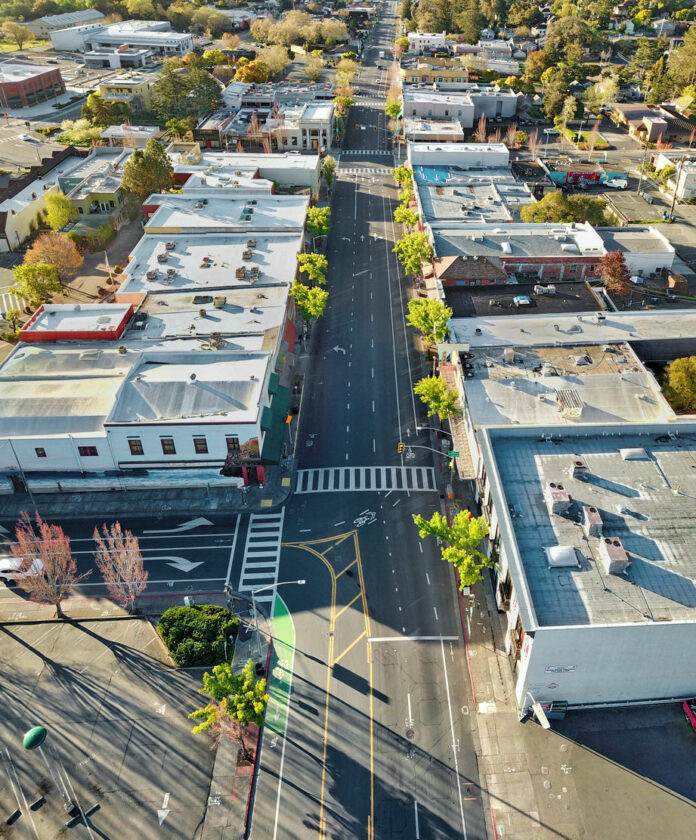The coronavirus pandemic is taking a devastating economic toll on Sonoma County’s economy: tourism, once a mainstay, is non-existent; 16,000 local workers have filed for unemployment; more than a thousand small businesses have applied for the federal Small Business Administration (SBA) Payroll Protection Plan (PPP). Meanwhile local governments continue to provide essential public health and welfare services, while their normal revenue sources trickle to near-zero.
While the aggressive shelter-in-place orders and public health warnings have kept the spread of the coronavirus at very low levels, with just two deaths after six weeks of a declared public health emergency, the economic costs in the county are just beginning to emerge.
“It’s bleak,” said a stunned county supervisor chair Susan Gorin after hearing a fiscal impact report on Tuesday from county auditor-treasurer Eric Roeser.
The county government has consumed $49.6 million in COVID-19-related costs, with $12 to $22 million of that total uncovered after anticipated FEMA emergency funds and other reimbursements.
“It’s very chilling,” said west county supervisor Lynda Hopkins, “and I have to say I am more worried about next year’s budget than this year’s. We’re facing a true change of life — one with reduced revenues and more expenses.”
Last week saw local banks scrambling to process thousands of small business loan applications, while still waiting for full details of the Small Business Administration PPP emergency loans. The $356 billion in Congress-approved funds was expected to run out by week’s end, while Democrats and Republicans haggled over a second bailout funding of $250 billion. Locally, banks were keeping “waiting lists” of businesses to keep from overwhelming the system.
“It has been a real spotty roll-out,” said Congressman Jared Huffman. “I’ve heard of a few successes, but a lot of people are being left out. There definitely needs to be a second wave of funding.”
Huffman said the original CARES package that was rushed through Congress needs fixes and has some red flags.
“I do feel we will have future waves of funding. Eight weeks of support is not enough; it’s too short a time frame. It’s important we fund a much longer time frame,” he said.
“We’re going to run of out the funds in the next couple days,” said Exchange Bank’s Michael Sullivan. He said 1,500 PPP loan applications were being processed in just 10 days. “The demand for this money is unbelievable. I’m amazed we have been able to do this much so quickly,” he said.
However, processing is one thing, and getting paid is another. Local lenders, including Summit State Bank, Redwood Credit Union and Exchange Bank, among others, have yet to get final documentation or final assurance of SBA funds.
Brian Reed, CEO of Summit State Bank said he hopes his bank can begin to fund customers within the next 10 days.
Reed said the bank has had to limit the program “to only existing bank customers because we know the money will run out.”
Beginning April 3, when the SBA issued preliminary PPP information, businesses here and across the country jammed the SBA and local banks’ websites. Local bank staff worked from their own homes over the weekend processing applications in “live time,” as the SBA was continuing to issue updates and new requirements.
The assortment of small business applicants were “across the board,” said Reed.
Hardest hit by the sudden shutdown of the local economy on March 18 is the local wine and hospitality sector. Sonoma County’s hotel occupancy rate was at 25% percent, almost 70% below the same time period one year ago. All local lodging establishments, of all sizes, have reduced staffing and payroll to minimum essential levels.
Although talk of “reopening” parts of the local economy is beginning, significant and long-lasting impacts already have been put in motion.
“I think the near-term is going to be slow, but muted on the negative side,” said Robert Eyler, economic professor at Sonoma State University. “The big issue is later summer and early fall as we may miss an entire tourism season here.”
He said the government loans and bailouts probably won’t be enough to save all local businesses. His fear was local businesses might close and workers will leave the area.
“There’s more costs to come, and much depends on when we exit: agriculture, construction, tourism and most important their supply chains,” he said.
Any new wave of the coronavirus in the fall or later could leave the local economy at near-half capacity, he said.
“Our best case scenario is we emerge from this situation cautiously and firmly, and it does not repeat when flu season comes back.”
Area business organizations as diverse as Sonoma County GO LOCAL and Sonoma County Winegrowers are busy doing member outreach and relief efforts. Local chambers of commerce have become information hubs for daily COVID-19 pandemic updates. The Santa Rosa Metro Chamber of Commerce is issuing one-time $2,000 grants to any Sonoma County business that applies.
“GO LOCAL is focusing at this time on promoting the offers and needs of our business and nonprofit members,” said executive director Janeen Murray. “We have a form that over 70 of our 450 members have submitted with their special offerings.”
She said she is finding local businesses “trapped” between dealing with their short-term money needs and maintaining their long-term business goals
Talia Hart, executive director of the Healdsburg Chamber of Commerce looked for a positive spin and offered, “The community is helping each other out tremendously, and there is a lot of support for local businesses through community members. I think you’ll see a large, local focus when we start to unsheltered.”
67.4
F
Healdsburg
April 18, 2025








